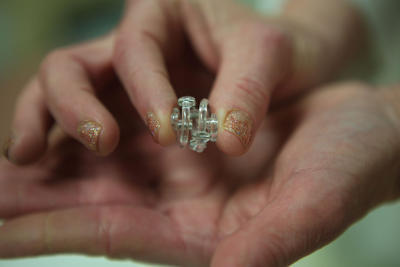
A thimble-sized coil allowed Kimberly Clifton, an avid East Mountain horsewoman, to deal with her breast cancer with less pain and more options for treatment.
“I was the first member of my family to have any type of cancer, so I really didn’t know what to expect. The lumpectomy went really well. I had a small tumor and I wanted to get it taken care of as soon as possible,” Clifton, 67, said of her surgery and radiation therapy this past summer. “It’s definitely a procedure I would recommend.”
The surgically implanted device called BioZorb dissolves, but leaves six eyelash-sized titanium markers in the three-dimensional space that marks where the tumor was removed, said Albuquerque surgeon Dr. Linda Ann Smith, one of the key researchers to demonstrate the effectiveness of the device.

“(It) helps direct tumor killing radiation precisely to cancerous cells, while minimizing damage to the remaining breast tissue, the heart and the lungs,” she said. “I’ve also seen that using BioZorb helps lead to a better cosmetic result after treatment.”
Breast cancer can be treated by removing the breast, mastectomy, or by a lumpectomy. With a lumpectomy, a small amount of tissue is removed, but scattered cancer cells may remain. The goal of radiation therapy treatments is to eliminate the remaining cancer cells, so the breast is saved, Smith said.
Traditionally radiation therapy targets large areas of the breast with higher dose treatments to the tumor bed.
“In radiation, normal cells die along with cancer cells,” she said. This lengthens the healing process and creates more scar tissue, which is often painful, she said. Aftereffects can last as long as 10 years.
The BioZorb device allows radiation to pinpoint the tumor bed more precisely, because the radiation oncologist can more readily see the markers on an imaging exam. Smith said the tumor bed could be several inches away from her incision.
The precision also creates more options for patients who have had heart surgeries or who may not be able to tolerate radiation near their heart and lungs.
The device markers also allow radiologists to keep a closer eye on the area in subsequent follow-up mammograms after surgery and treatments are complete.
In her 20 years of surgical practice, Smith said she’s seen lumpectomies that were more disfiguring than a mastectomy would have been: “It can look like shark bites in the breast tissue. Those shark bites looked pretty bad, maybe worse than a mastectomy. It’s been a steep learning curve for 20 years. We want our patients to come out with a functional breast and have a better quality of life.”
Smith collaborated with Lovelace Women’s Hospital to perform the first surgeries in the region with the BioZorb device.

She presented results of more than 40 surgeries with BioZorb at a recent international breast care symposium with her co-author, Dr. Robert Kuske of Arizona Breast Cancer Specialists. He developed accelerated partial breast irradiation, a five-day alternative to conventional, more lengthy whole-breast irradiation for many early-stage breast cancer patients.
Clifton was a candidate for five-day brachytherapy with Dr. Ruske. The twice-a-day treatment involved threading a tiny catheter with radiation buttons to the identified area. “It looked like polka-dots as it healed. It was a little tender. There was some discomfort, but I didn’t have any pain,” Clifton said.
On advice from her medical team she didn’t have any chemotherapy. “We cautiously agreed. I feel very confident with this kind of radiation,” she said.
She said her breast cancer was less of an ordeal than she feared and she hardly lost any time riding her favorite horse, Dandy. She said she’s grateful for a wonderful husband, Marty, and loving support from her family.
“We had a strong prayer team going. For someone like me, cancer doesn’t have to be the scary word it used to be five or 10 years ago. I hope the things they can do to treat breast cancer today will encourage others who have been diagnosed with the disease.”
By Donna Olmstead / Journal Staff Writer
This is an archive of an article published Monday, January 26, 2015 from the Albuquerque Journal used for educational purposes. Read the original article here

